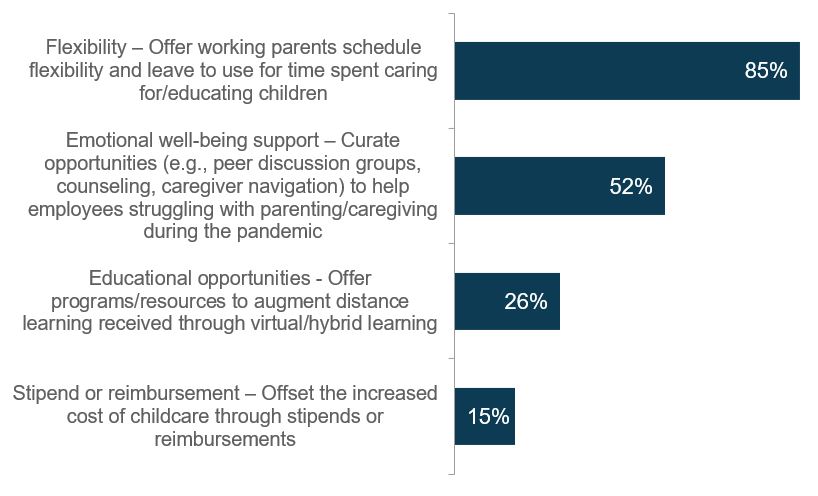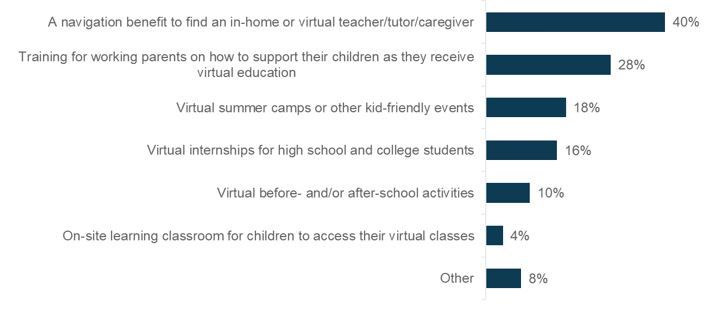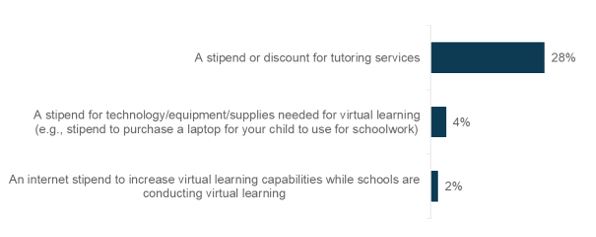December 17, 2020
The COVID-19 pandemic created challenges for caregivers unlike any they had ever experienced before – and seemingly each employee faces different scenarios. Knowing that they can’t take a one-size-fits-all approach, employers are currently offering a variety of ways to support employees – ranging from flexible scheduling to virtual educational support to initiatives to help lower stress.
This set of Key Insights will cover data and employer examples shared on two employer benchmarking calls hosted by Business Group on Health in October and November 2020.
As seen in Figure 1, employers are approaching childcare support in four distinct ways: by being flexible; offering resources for mental health and emotional well-being; supporting educational opportunities and providing stipends/reimbursements for childcare; and educational expenses. Providing schedule flexibility is the most common approach, but other options are also being deployed by many employers.

Source: The Childcare and Caregiver Crunch Benchmarking Call Poll, October 16, 2020.
Flexibility
Because employees’ needs vary based on their own caregiving demands and circumstances, a natural first step for employers is to offer job flexibility to allow employees to balance their work with caretaking demands. Figure 2 outlines design options for job flexibility – ranging from the most common flexible work hours, to the less common job-sharing and sabbatical options, which may not be feasible for some job types and industries.
A few employers shared some tips for creating a flexible work environment:

Source: Quick Survey Findings: Supporting Employees with School-Aged Children During the Pandemic
- One employer highlighted the importance of protecting personal and family time so employees working from home don’t experience burnout. The company promotes “do not disturb” time, during which employees block off protected time on their calendars for lunch with their family or to take a walk.
- Another employer shared a different perspective, largely because t the company has been facing demand for products during the pandemic. Therefore, it has had to offer a variety of supports depending on the employee’s job. Plant employees were asked to report to work as much as possible to meet production demands, while salaried employees didn’t face the same demands. In the end, this company has learned to flex with schedules and needs by working with managers and supervisors.
- Some global employers shared that they would like to implement a minimum standard for flexibility; employees across the world are facing these same challenges, yet there is significant variation country-by-country. These companies noted the challenges in creating a global flexibility policy. In the meantime, they are looking to family care benefits as a way to support working parents and caregivers.
Mental Health and Emotional Well-being
According to survey data portrayed in Figure 3, 84% of employers are targeting mental health/emotional well-being efforts to working parents. Employee Resource Groups and peer-to-peer support are also common (and low-cost!) ways to help employees cope with the pressures of parenting during the pandemic.
Employers shared a variety of approaches on the benchmarking calls, ranging from apps, coaching, counseling, social media, volunteering or peer support:
- One employer’s mental and emotional health support is delivered through apps, coaching, free virtual therapy visits and providing connections to those who can support employees within the community.

Source: Quick Survey Findings: Supporting Employees with School-Aged Children During the Pandemic
- Another employer went the app route by rolling out Lyra. For supervisors, this employer developed a two-page guide to help managers and supervisors support employees by directing them to resources that could help them in their situation.
- Three employers on the line use Rethink globally; one employer uses it specifically to support parents who need developmental care guidance.
- An employer that has expanded and promoted its EAP and work/life programs has seen a substantial increase in utilization.
- One employer shared an interesting new idea: connecting employees to volunteer programs like Papa, which can also provide caregiver support to parents and those caring for their own parents.
- Employers are also organizing and promoting peer support groups, recognizing how powerful those connections can be. Two employers mentioned this approach on the calls. One has created a Yammer page for U.S. employees who are parents. This network provides reminders of important events, gives feedback on benefits and programs, and provides many parenting tips for getting through the pandemic. Another employer is looking to bring groups of associates together to share ideas.
Virtual Education Support
Knowing that many employees have had to take a more active role in their children’s schooling, employers began offering benefits and designing learning opportunities to augment virtual learning. As shown in Figure 4, a navigational benefit to help employees find a tutor or caregiver is the most common way employers are supporting the educational needs of employees’ dependents, followed by training on virtual education and virtual summer camps.
- One employer has organized learning pods in which small groups of children are doing remote learning together. Through Sittercity, employees are able to find a caregiver to oversee all the children in a pod. Employees can use their dependent care flexible spending accounts to pay for the cost of the pod. The employer provides a free 12-month subscription to Sittercity to all eligible employees.

Source: Quick Survey Findings: Supporting Employees with School-Aged Children During the Pandemic
Employers shared their approaches to meeting the educational needs of dependents:
- Recognizing the educational challenges of older children, another employer designed a college coach program with Bright Horizons. In addition, this company offers individual and group virtual academic support to children ages 3 and up.
- One employer created a pilot program called Kids Club to help occupy children during the summer months through various on-demand and live learning courses. Although parents were willing to pay for access to the classes, the company decided to cover the costs. The company was able to get the program off the ground in 4 weeks, partly due to an internal initiative that reallocated employees who had more bandwidth during the pandemic to help build out the program. STEM and cooking classes were very popular. In all, over 1,000 kids from 37 countries participated over the course of 7 weeks. If the company were to do the program again, it would leverage local vendors to accommodate varying time zones. The site is still available for employees to use, containing links to on-demand resources. The program cost about $350K-$400K, most of which was spent on the cost of bringing on educators for the live classes. This program was extremely successful with one out of three employees with children aged 5-12 participating, and 80% rated their experience with Kids Club as positive.
Financial Support/Childcare Subsidies
During the pandemic, many employees have faced unexpected childcare costs as a result of public schools shutting down for in-person instruction. Knowing the impact on their workforces’ financial well-being, a minority of employers are providing subsidies to help defray the costs of childcare, including tutoring. According to Quick Survey results depicted in Figure 5, 28% of employers are offering a stipend or discount for tutoring services.
Here are some examples of discounts, subsidies and reimbursements that employers are offering:
- Free memberships to navigators like Bright Horizons, Sittercity and care.com.

- Reimbursement of care provided by family members at $100/day.
- Pay for 12 days of backup care for both children and adults.
- Increased backup care to 40 days from 30.
- Twenty days of backup care globally; the U.S. has the highest utilization compared to the U.K. and India.
- Childcare reimbursement program for COVID-19 through the end of 2020, with expansion into 2021 under consideration.
- Bright Horizons hub for access to primary childcare solutions and academic support/tutoring at a discount (not subsidized).
- Back to Basics, which offers a discount for services for tutoring, homework help and skill building.
Communications
With employers offering so many options to support caregivers, communications about the benefits necessitates a strategy that’s clear, concise and easy to access. In fact, 31% of employers on one of the calls said that they are changing the way they communicate or administer childcare benefits in 2021.
Here are some impactful ways that employers have communicated childcare benefits and offerings:
- Created an infographic that acts as a flowchart, directing employees to different paths based on how they answer a question (e.g., do you need on-site childcare or care in the home?).
- Designed a one-stop-shop webpage as part of the COVID-19 page. It includes drop downs to view more materials/resources, articles and ancillary resources on financial well-being and mental health.
- Created a network of parents to pilot programs and curate content, using the Circle In platform.
- Conducted COVID-19 sessions where the focus is not just on talking about childcare, but instead on everything the company is trying to do to support employees throughout the pandemic. HR staff were on hand to summarize all of the benefits that are available to employees.
- Designed a consolidated layover page on the company’s intranet with a list of all of the benefits available; employees can dig deeper into everything that’s available.
Conclusion
Looking toward 2021, a majority of employers on the line (56%) say they are planning to offer even more childcare or caregiving benefits. This is a surprising turn of events, given that so many employers reworked their offerings in 2020. In the end, it indicates large employers’ investment in supporting employees who serve as caregivers during the COVID-19 pandemic and beyond.
More Topics
Articles & Guides
This content is for members only. Already a member?
Login
![]()
